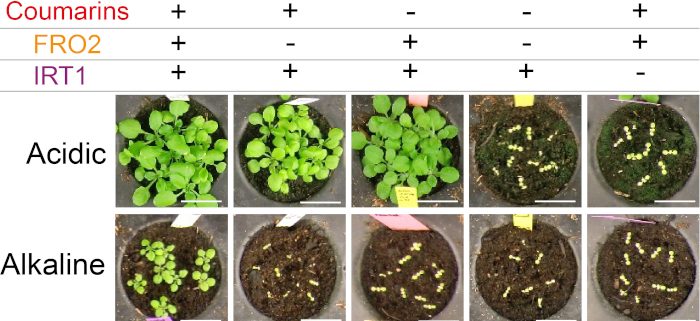Strategy-I plants exploit the distinct chemical activities of coumarins to maximize Fe acquisition
Paffrath et al. explore the main physiological roles of coumarins released in response to iron deficiency under different environmental pHs.
https://doi.org/10.1093/plcell/koad279
By Ricardo F. H. Giehl, Leibniz Institute of Plant Genetics & Crop Plant Research (IPK), Germany.
Background: Although iron (Fe) is abundant in the Earth’s crust, the availability of this micronutrient to plants is often low under slightly acidic to alkaline pH conditions. Non-graminaceous species, such as Arabidopsis (Arabidopsis thaliana), rely on the “strategy I” Fe acquisition mechanism, which requires the reduction of Fe(III) prior to uptake. These plants are typically more prone to high pH-induced Fe deficiency because Fe(III) reductase activity is pH sensitive, such as that of FERRIC REDUCTION OXIDASE2 (FRO2). Iron acquisition in species employing the reduction-based strategy is often supported by the release of coumarins, secondary metabolites derived from the phenylpropanoid pathway.
Questions: Do the redox-active coumarins secreted by Fe-deficient A. thaliana plants contribute to ferric Fe reduction in roots? If so, how this function is linked to FRO2? How are coumarin composition and the chemical activities of distinct coumarins modulated by environmental pH?
Findings: With chemical complementation experiments and by disrupting single steps of the coumarin biosynthesis pathway in the fro2 mutant, we revealed that coumarins play a physiologically relevant role in Fe(III) reduction. We demonstrated that sideretin is the dominant chemical reductant in Arabidopsis and, with FRO2, contributes to generating Fe(II) for root uptake under acidic conditions. At alkaline pH, transcription factor MYB72 shifts coumarin biosynthesis away from sideretin and toward fraxetin. Under these conditions, instead of ferric Fe reduction, the predominant function of fraxetin is to provide soluble Fe(III) substrates for FRO2.
Next steps: Future studies are needed to determine whether there is genetic variability for coumarin-mediated ferric Fe reduction and to characterize the putative role of MYB72 in pH-dependent modulation of coumarin composition. Furthermore, it will be of interest to investigate whether and how coumarin-mediated Fe(III) reduction affects the root microbiota.
Reference:
Vanessa Paffrath, Yudelsy A. Tandron Moya, Günther Weber, Nicolaus von Wirén and Ricardo F.H. Giehl. (2023). A major role of coumarin-dependent ferric iron reduction in strategy I-type iron acquisition in Arabidopsis. https://doi.org/10.1093/plcell/koad279




